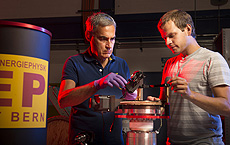UV laser calibration system installed in MicroBooNE
 |
| Antonio Ereditato (left), head of the Laboratory for High Energy Physics at the University of Bern, and scientist Thomas Strauss, also of the University of Bern, work on MicroBooNE's UV laser calibration system. Photo: Reidar Hahn |
Fermilab's MicroBooNE experiment, expected to launch in early 2015, could very well help determine whether a hypothesized fourth neutrino — referred to as a sterile neutrino — would join the three confirmed ones. Anticipating significant, perhaps momentous, findings, Fermilab and outside collaborators are working hard to ready MicroBooNE for take-off.
In late September, MicroBooNE collaborators installed a new ultraviolet (UV) laser calibration system in MicroBooNE's liquid-argon detector at Fermilab. Scientists at Switzerland's University of Bern Laboratory for High Energy Physics, a MicroBooNE collaborator, designed and built the system specifically for the project.
"This is exciting," said Fermilab's Sam Zeller, MicroBooNE co-spokesperson. "This is the first time anyone has deployed such a laser system in a liquid-argon detector for a major neutrino experiment."
Fermilab's MiniBooNE experiment (MicroBooNE's predecessor) and Los Alamos National Laboratory's Liquid Scintillator Neutrino Detector experiment raised the possibility of a fourth neutrino. However, the two experiments, while producing many cited — and some differing — results, did not have sensitive liquid-argon detectors for charting neutrino activity.
"We are recreating that same short-beamline environment, but with MicroBooNE, which has a more capable detector," said University of Bern's Michele Weber, MicroBooNE physics analysis coordinator. "We now have some means to address this new neutrino question."
Because of the high-resolution imaging capability of liquid-argon detectors such as MicroBooNE's, it is important to ensure and monitor their correct functioning. One of the calibration system's goals is to check the detector's electric field and how it transfers deposits of charge, caused by neutrino interactions with the liquid argon, to the detector's readout wires.
With the University of Bern's UV laser calibration system, ultraviolet laser beams, which are reliably straight, are shot through the argon-filled chamber when the neutrino beam is not activated to test whether the detector's critical components — wiring, electrical field — are operating maximally or are skewing data readings.
Physicist Antonio Ereditato, who heads the University of Bern laboratory, explains that a normal visible-light laser does not have enough energy to ionize the liquid argon and create tracks similar to those caused by the neutrinos. But a laser using ultraviolet light, which is higher in energy than visible light, can do the job under specific conditions.
"The system creates 'artificial' tracks that mimic the ionization tracks left by particles. In short, this ultraviolet laser system checks, monitors and calibrates the liquid-argon detector," Ereditato said.
"That allows us to measure possible image distortions everywhere," Weber said. Those distortions can then be accounted for in the data.
The laser calibration system took eight years of R&D studies to develop. The Bern team also tested it on a liquid-argon detector prototype at their lab.
"I always joke with the Bern team that the calibration system they built is like a Swiss watch," Zeller said. "The laser itself, like exquisite clockwork, sweeps across the detector. It is absolutely beautiful."
Ereditato and Weber are also very happy with the system. They feel the MicroBooNE experiment embodies the international cooperation and goodwill that bodes well for the future of particle physics.
"This experiment, which we worked so hard on, and Fermilab's opening their doors and recognizing our work is very satisfying," Weber said.
"If there is another neutrino, it could open up an entirely new particle family — so there is some exciting physics possibly around the corner," Zeller said. "We are ready to get going."
—Rich Blaustein
|